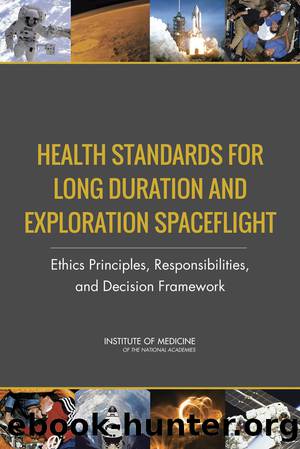Health Standards for Long Duration and Exploration Spaceflight: Ethics Principles, Responsibilities, and Decision Framework by Jeffrey Kahn

Author:Jeffrey Kahn
Language: eng
Format: epub
Tags: ebook
Publisher: The National Academies Press
Published: 2014-07-04T00:00:00+00:00
Regulations for Research Involving Human Participants
Although the committee was not tasked with establishing an ethics framework to govern astronauts as research participants in space,21 federal regulations governing human participation in research provide some of the best understood and accepted examples of ethics principles that govern risk exposures to individuals. Building upon key documents describing ethical research conduct,22 the U.S. Department of Health and Human Services has adopted extensive regulations that govern federally supported or conducted research involving human participants.23
Independent oversight is an essential component of ethical research involving human participants. Under the Common Rule,24 any research protocol involving humans must be submitted to an institutional review board (IRB), which is an administrative committee formally designated to review, approve, and potentially modify research involving humans (HHS, 1993). IRBs serve as the principal representatives of the interests of potential research participants (IOM, 2002b), functioning independently of, but in coordination with, other research-related entities (HHS, 1993). IRBs oversee not only the initial approval of a research protocol, but are also responsible for continuing review of ongoing research.25
As a general rule in research, as risks to individual research participants increase, so do the necessary levels of review, oversight, and the requisite, potential benefits. The Common Rule states that research may be approved only if risks to participants are minimized, if the risks of participation in a specific research protocol are reasonable in relation to the anticipated benefits and âthe importance of the knowledge that may reasonably be expected to result.â26 Additionally, IRBs may only approve research protocols that include equitable selection of participants, safeguard and document informed consent and voluntariness of participation, provide adequate provisions for monitoring data collection to ensure participant safety, and ensure adequate protections of participant privacy and data confidentiality.27
Specific types of high-risk research may require continuous monitoring and review of study data to protect participant health and safety. For example, the National Institutes of Health (NIH) requires Data and Safety Monitoring Boards (DSMBs) for multisite trials that involve potentially risky interactions (NIH, 1998). Within NIH, the primary responsibilities of a DSMB include evaluation of monitoring systems for data to maintain participant safety; ensure data validity and integrity; evaluate study progress; and issue recommendations about the continuation or termination of a trial (NIH, 1998). DSMBs may terminate studies early if results indicate a clear risk or benefit to the study participants (NIDCR, 2014).
Even if an IRB and institution approve the levels of risk included in a specific research protocol, potential human research participants do not need to accept those risks. With few exceptions, âno investigator may involve a human being as a subject in research ⦠unless the investigator has obtained the legally effective informed consent of the subject or the subjectâs legally authorized representative.â28 Proper informed consent involves sufficient opportunity to consider the risks and benefits of the research and should âminimize the possibility of coercion or undue influence.â29Among other requirements, basic elements of informed consent include a written explanation of the purpose, procedures, and expected risks and benefits of the research, as well as a description of how confidential records will be protected.
Download
This site does not store any files on its server. We only index and link to content provided by other sites. Please contact the content providers to delete copyright contents if any and email us, we'll remove relevant links or contents immediately.
Application of a Novel Technique for Clinical Evaluation of Nitric Oxide-Induced Free Radical Reactions in ICU Patients by Unknown(694)
Rosenâs Emergency Medicine Concepts and Clinical Practice by Ron Walls; Robert Hockberger; Marianne Gausche-Hill; Timothy B. Erickson; Susan R. Wilcox(572)
Oxidative damage to surfactant protein D in pulmonary diseases by Vitality Starosta1 & Matthias Griese1†(406)
Social Science Perspectives on Global Public Health by Vincent La Placa & Julia Morgan(372)
Constructing Canine Consent; Conceptualising and Adopting a Consent-focused Relationship with Dogs by ERIN JONES(329)
Organic Chemistry: An Acid - Base Approach by MICHAEL SMITH(299)
ADVANCED EMERGENCY CARE AND TRANSPORTATION OF THE SICK AND INJURED by Unknown(271)
Saunders Nursing Drug Handbook 2024 - E-Book by Unknown(262)
Davis's Comprehensive Manual of Laboratory and Diagnostic Tests with Nursing Implications by Unknown(245)
Diagnostic and Statistical Manual of Mental Disorders, Fifth Edition, Text Revision (DSM-5-TR(tm)) by Unknown(245)
Socio-Life Science and the COVID-19 Outbreak : Public Health and Public Policy by Makoto Yano; Fumihiko Matsuda; Anavaj Sakuntabhai; Shigeru Hirota(244)
Human Microanatomy; Cell Tissue and Organ Histology with Celebrity Medical Histories by Stephen A. Stricker(243)
Berne and Levy Physiology E-Book by Unknown(234)
Replacing the Dead by Mie Nakachi;(229)
Handbook of Skin Disease Management by Jiyad Zainab;Flohr Carsten; & Carsten Flohr(228)
Access to Medicines and Vaccines in the South : Coherence of Rules and Policies Applied by the European Union Commission by Stephen Kingah(225)
The Pocket Guide to Sensorimotor Psychotherapy in Context (Norton Series on Interpersonal Neurobiology) by Pat Ogden(218)
Deep Learning and Medical Applications by Unknown(217)
Advances and Technical Standards in Neurosurgery by Unknown(213)
